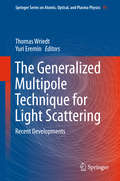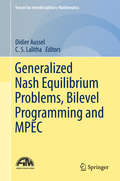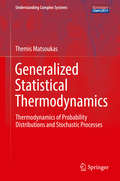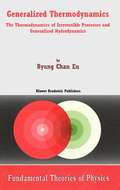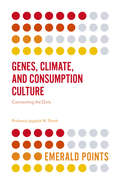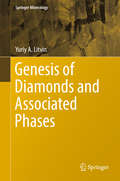- Table View
- List View
Generalized Mathieu Series
by Živorad Tomovski Delčo Leškovski Stefan GerholdThe Mathieu series is a functional series introduced by Émile Léonard Mathieu for the purposes of his research on the elasticity of solid bodies. Bounds for this series are needed for solving biharmonic equations in a rectangular domain. In addition to Tomovski and his coauthors, Pogany, Cerone, H. M. Srivastava, J. Choi, etc. are some of the known authors who published results concerning the Mathieu series, its generalizations and their alternating variants. Applications of these results are given in classical, harmonic and numerical analysis, analytical number theory, special functions, mathematical physics, probability, quantum field theory, quantum physics, etc. Integral representations, analytical inequalities, asymptotic expansions and behaviors of some classes of Mathieu series are presented in this book. A systematic study of probability density functions and probability distributions associated with the Mathieu series, its generalizations and Planck’s distribution is also presented. The book is addressed at graduate and PhD students and researchers in mathematics and physics who are interested in special functions, inequalities and probability distributions.
The Generalized Multipole Technique for Light Scattering: Recent Developments (Springer Series on Atomic, Optical, and Plasma Physics #99)
by Thomas Wriedt Yuri EreminThis book presents the Generalized Multipole Technique as a fast and powerful theoretical and computation tool to simulate light scattering by nonspherical particles. It also demonstrates the considerable potential of the method. In recent years, the concept has been applied in new fields, such as simulation of electron energy loss spectroscopy and has been used to extend other methods, like the null-field method, making it more widely applicable. The authors discuss particular implementations of the GMT methods, such as the Discrete Sources Method (DSM), Multiple Multipole Program (MMP), the Method of Auxiliary Sources (MAS), the Filamentary Current Method (FCM), the Method of Fictitious Sources (MFS) and the Null-Field Method with Discrete Sources (NFM-DS). The Generalized Multipole Technique is a surface-based method to find the solution of a boundary-value problem for a given differential equation by expanding the fields in terms of fundamental or other singular solutions of this equation. The amplitudes of these fundamental solutions are determined from the boundary condition at the particle surface. Electromagnetic and light scattering by particles or systems of particles has been the subject of intense research in various scientific and engineering fields, including astronomy, optics, meteorology, remote sensing, optical particle sizing and electromagnetics, which has led to the development of a large number of modelling methods based on the Generalized Multipole Technique for quantitative evaluation of electromagnetic scattering by particles of various shapes and compositions. The book describes these methods in detail.
Generalized Nash Equilibrium Problems, Bilevel Programming and MPEC (Forum for Interdisciplinary Mathematics)
by Didier Aussel C. S. LalithaThe book discusses three classes of problems: the generalized Nash equilibrium problems, the bilevel problems and the mathematical programming with equilibrium constraints (MPEC). These problems interact through their mathematical analysis as well as their applications. The primary aim of the book is to present the modern tool of variational analysis and optimization, which are used to analyze these three classes of problems. All contributing authors are respected academicians, scientists and researchers from around the globe. These contributions are based on the lectures delivered by experts at CIMPA School, held at the University of Delhi, India, from 25 November–6 December 2013, and peer-reviewed by international experts. The book contains five chapters. Chapter 1 deals with nonsmooth, nonconvex bilevel optimization problems whose feasible set is described by using the graph of the solution set mapping of a parametric optimization problem. Chapter 2 describes a constraint qualification to MPECs considered as an application of calmness concept of multifunctions and is used to derive M-stationarity conditions for MPEC. Chapter 3 discusses the first- and second-order optimality conditions derived for a special case of a bilevel optimization problem in which the constraint set of the lower level problem is described as a general compact convex set. Chapter 4 concentrates the results of the modelization and analysis of deregulated electricity markets with a focus on auctions and mechanism design. Chapter 5 focuses on optimization approaches called reflection methods for protein conformation determination within the framework of matrix completion. The last chapter (Chap. 6) deals with the single-valuedness of quasimonotone maps by using the concept of single-directionality with a special focus on the case of the normal operator of lower semi-continuous quasiconvex functions.
Generalized Statistical Thermodynamics: Thermodynamics of Probability Distributions and Stochastic Processes (Understanding Complex Systems)
by Themis MatsoukasThis book gives the definitive mathematical answer to what thermodynamics really is: a variational calculus applied to probability distributions. Extending Gibbs's notion of ensemble, the Author imagines the ensemble of all possible probability distributions and assigns probabilities to them by selection rules that are fairly general. The calculus of the most probable distribution in the ensemble produces the entire network of mathematical relationships we recognize as thermodynamics. The first part of the book develops the theory for discrete and continuous distributions while the second part applies this thermodynamic calculus to problems in population balance theory and shows how the emergence of a giant component in aggregation, and the shattering transition in fragmentation may be treated as formal phase transitions. While the book is intended as a research monograph, the material is self-contained and the style sufficiently tutorial to be accessible for self-paced study by an advanced graduate student in such fields as physics, chemistry, and engineering.
Generalized Thermodynamics: The Thermodynamics of Irreversible Processes and Generalized Hydrodynamics (Fundamental Theories of Physics #124)
by Byung Chan EuDespite a long history of almost 180 years stretching back to the times of Carnot and, later, Clausius and Lord Kelvin, amongst others following him, the subject of thermodynamics has not as yet seen its full maturity, in the sense that the theory of irreversible processes has remained incomplete. The works of L. Onsager, J. Meixner, I. Prigogine on the thermodyn- ics of linear irreversible processes are, in effect, the early efforts toward the desired goal of giving an adequate description of irreversible processes, but their theory is confined to near-equilibrium phenomena. The works in recent years by various research workers on the extension of the aforem- tioned thermodynamic theory of linear irreversible processes are further efforts toward the goal mentioned. The present work is another of such efforts and a contribution to the subject of generalizing the thermodyn- ics of reversible processes, namely, equilibrium thermodynamics, to that of irreversible processes—non-equilibrium thermodynamics, without being restricted to linear irreversible processes. In this context the terms ‘far - moved from equilibrium’ is often used in the literature, and such states of macroscopic systems and non-linear irreversible phenomena in them are the objects of interest in this work. The thermodynamics of processes, either reversible or irreversible, is a continuum mechanical theory of matter and energy and their exchange between different parts of the system, and as such it makes no direct r- erence to the molecules constituting the substance under consideration.
Generalized Vertex Algebras and Relative Vertex Operators (Progress in Mathematics #112)
by Chongying Dong James LepowskyThe rapidly-evolving theory of vertex operator algebras provides deep insight into many important algebraic structures. Vertex operator algebras can be viewed as "complex analogues" of both Lie algebras and associative algebras. The monograph is written in a n accessible and self-contained manner, with detailed proofs and with many examples interwoven through the axiomatic treatment as motivation and applications. It will be useful for research mathematicians and theoretical physicists working the such fields as representation theory and algebraic structure sand will provide the basis for a number of graduate courses and seminars on these and related topics.
Generalized Wavelets and Hypergroups
by Khalifa TrimecheWavelets have recently been enjoying a period of popularity and rapid growth, and the influence of wavelet methods now extends well beyond mathematics into a number of practical fields, including statistics. The theory of hypergroups can be traced back to the turn of the century, and following its formalization in the early 1970s, the area has now
Generalized Wavelets and Hypergroups
by Khalifa TrimecheWavelets have recently been enjoying a period of popularity and rapid growth, and the influence of wavelet methods now extends well beyond mathematics into a number of practical fields, including statistics. The theory of hypergroups can be traced back to the turn of the century, and following its formalization in the early 1970s, the area has now
Generated Dynamics of Markov and Quantum Processes
by Martin JanßenThis book presents Markov and quantum processes as two sides of a coin called generated stochastic processes. It deals with quantum processes as reversible stochastic processes generated by one-step unitary operators, while Markov processes are irreversible stochastic processes generated by one-step stochastic operators. The characteristic feature of quantum processes are oscillations, interference, lots of stationary states in bounded systems and possible asymptotic stationary scattering states in open systems, while the characteristic feature of Markov processes are relaxations to a single stationary state. Quantum processes apply to systems where all variables, that control reversibility, are taken as relevant variables, while Markov processes emerge when some of those variables cannot be followed and are thus irrelevant for the dynamic description. Their absence renders the dynamic irreversible. A further aim is to demonstrate that almost any subdiscipline of theoretical physics can conceptually be put into the context of generated stochastic processes. Classical mechanics and classical field theory are deterministic processes which emerge when fluctuations in relevant variables are negligible. Quantum mechanics and quantum field theory consider genuine quantum processes. Equilibrium and non-equilibrium statistics apply to the regime where relaxing Markov processes emerge from quantum processes by omission of a large number of uncontrollable variables. Systems with many variables often self-organize in such a way that only a few slow variables can serve as relevant variables. Symmetries and topological classes are essential in identifying such relevant variables. The third aim of this book is to provide conceptually general methods of solutions which can serve as starting points to find relevant variables as to apply best-practice approximation methods. Such methods are available through generating functionals. The potential reader is a graduate student who has heard already a course in quantum theory and equilibrium statistical physics including the mathematics of spectral analysis (eigenvalues, eigenvectors, Fourier and Laplace transformation). The reader should be open for a unifying look on several topics.
Generating Families in the Restricted Three-Body Problem: II. Quantitative Study of Bifurcations (Lecture Notes in Physics Monographs #65)
by Michel HenonGenerating Families in the Restricted Three-Body Problem (Lecture Notes in Physics Monographs #52)
by Michel HenonGeneration, Accumulation and Production of Europe’s Hydrocarbons III: Special Publication of the European Association of Petroleum Geoscientists No. 3 (Special Publication of the European Association of Petroleum Geoscientists #3)
by Anthony M. SpencerThe 30 contributions of this volume cover the main European regions for oil and gas exploration: the North Sea and adjacent areas, the central and eastern Mediterranean including offshore Albania, central and eastern Europe including Poland, Hungary, the Russian platform and offshore Bulgaria. Main topics are investigations to sequence stratigraphy, 3D-quantitative restoration and balanced structural sections, using the LOCACE equipment. Additional studies deal with a Monte Carlo method for generating models of porosity and permeability, with facies characterization using wireline logs or with petrographic applications of image analysis. As further reading this volume is of significant interest for researchers in oil and gas industries but also for scientists at universities.
The generation of high magnetic fields (The International Cryogenics Monograph Series)
by David H. ParkinsonGenes, Climate, and Consumption Culture: Connecting the Dots (PDF) (Emerald Points)
by Professor Jagdish N. ShethDrawing from decades of research, Genes, Climate, and Consumption Culture: Connecting the Dots demonstrates how climate dictates culture and consumption. The author shows that human genes are climatic adaptations over thousands of years of evolution, which has resulted in the dramatic differences between people’s food, clothing, and shelter choices. Most importantly, the book discusses how many of the fundamental differences between cultures, with respect to time, space, friendship, and technology, are responses to their particular climate. Readers will learn how to challenge their assumptions about what types of products and services foreign markets want. They will learn how to examine local markets vis-à-vis climate and culture, either changing their products accordingly or delivering entirely new offerings.
Genes, Climate, and Consumption Culture: Connecting the Dots (Emerald Points)
by Professor Jagdish N. ShethDrawing from decades of research, Genes, Climate, and Consumption Culture: Connecting the Dots demonstrates how climate dictates culture and consumption. The author shows that human genes are climatic adaptations over thousands of years of evolution, which has resulted in the dramatic differences between people’s food, clothing, and shelter choices. Most importantly, the book discusses how many of the fundamental differences between cultures, with respect to time, space, friendship, and technology, are responses to their particular climate. Readers will learn how to challenge their assumptions about what types of products and services foreign markets want. They will learn how to examine local markets vis-à-vis climate and culture, either changing their products accordingly or delivering entirely new offerings.
Genesis and Properties of Collapsible Soils (Nato Science Series C: #468)
by E. DerbyshireCollapsing engineering soils are a formidable hazard around the world. These difficult materials also include some of the world's most fertile agricultural soils, fostering dense human populations which are therefore increasingly at risk. Despite an impressive literature on the engineering aspects of collapsing soils, these materials are coming under increasing scrutiny by scientists in other fields. This is most evidently the case with soil scientists, stratigraphers and sedimentologists. Past earth surface conditions have a direct influence on the detailed behaviour of collapsible soils: as a complement, these materials also provide detailed data on changing global climates. The selected papers presented here highlight the common ground between three scientific groups with a vested interest in a better understanding of collapsible soils.
Genesis - In The Beginning: Precursors of Life, Chemical Models and Early Biological Evolution (Cellular Origin, Life in Extreme Habitats and Astrobiology #22)
by Joseph SeckbachGenesis – In The Beginning deals with the origin and diversity of Life and early biological evolution and discusses the question of where (hot or cold sources) and when the beginning of Life took place. Among the sections are chapters dealing with prebiotic chemical processes and considering self-replication of polymers in mineral habitats. One chapter is dedicated to the photobiological regime on early Earth and the emergence of Life. This volume covers the role of symmetry, information and order (homochrial biomolecules) in the beginning of Life. The models of protocells and the genetic code with gene transfer are important topics in this volume. Three chapters discuss the Panspermia hypothesis (to answer “Are we from outer Space?”). Other chapters cover the Astrobiological aspects of Life in the Universe in extraterrestrial Planets of the Solar System and deal with cometary hydrosphere (and its connection to Earth). We conclude with the history and frontiers of Astrobiogy.
The Genesis Mission
by C. T. RussellNASA's Genesis mission, launched on August 8, 2001 is the fifth mission in the Discovery series. Genesis addresses questions about the materials and processes involved in the origin of the solar system by providing precise knowledge of solar isotopic and elemental compositions for comparison with the compositions of meteoritic and planetary materials. This book describes the Genesis mission, the solar wind collector materials, the solar wind concentrator and simulations of its performance, the plasma ion and electron instruments, and the way these two instruments are used to determine the solar wind flow regime on board the spacecraft. The book is of interest to all potential users of the data returned by the Genesis mission, to those studying the isotopic and chemical composition of the early solar system whose work will be influenced by the measurements made by Genesis and by all those interested in the design and implementation of space instruments to study space plasmas.
Genesis of Diamonds and Associated Phases (Springer Mineralogy)
by Yuriy A. LitvinThis book presents an overview of recent advances in our understanding of the genesis of diamonds and the associated phases. It is divided into three main parts, starting with an introduction to the analysis of diamond inclusions to infer the formation processes. In turn, the second part of the book presents high-pressure experimental studies in mantle diamond-parental mineral systems with representative multicomponent boundary compositions. The experimental syngenesis phase diagrams provided reveal the physicochemical mechanisms of diamond nucleation and substantiate the mantle-carbonatite concept of the genesis of diamonds and associated phases. Lastly, the book describes the genetic classification of diamond-hosted mineral inclusions and experimentally determined RE “mineral-parental melt” partition coefficients. The physicochemical experimental evidence presented shows the driving forces behind the fractional evolution of the mantle magmas and diamond-parental melts.Given the depth and breadth of its coverage, the book offers researchers essential new insights into the ways diamonds and associated minerals and rocks are naturally created.
The Genesis of Geopolitics and Friedrich Ratzel: Dismissing The Myth Of The Ratzelian Geodeterminism (Historical Geography and Geosciences)
by Alexandros StogiannosThis book discusses the influence of Friedrich Ratzel's ideas in more contemporary geopolitical analytical systems and the geodeterminism commonly attributed to him. The author thoroughly analyzes the structural components of Ratzel's thought. The research is inspired by the numerous contradictory approaches in the secondary literature, presenting Ratzel as both humanist and racist, geo-determinist and multidimensional analyst, organicist and social scientist, precursor of Geopolitics and opponent to the same idea. In this work, more particular issues are approached: the establishment of a scientific Political Geography; the methodological approach of his multidisciplinary work; the redefinition of his geopolitical period; his notion of state and the evaluation of sociological and cultural parameters as factors of state power; the biogeographical content of the notion of Lebensraum; his attitude towards the racist theories as well as towards the Darwinian theories; his overall worldview and the confrontation with cosmopolitism; his contribution to an interdisciplinary, positivist and scientific approach in analyzing social and international affairs; his thoughts on the architecture of Europe. The book will be useful for researchers and students in many scientific fields, such as International Relations, Geopolitics, Geography and History of Geography.
Genetic Aspects of Plant Mineral Nutrition: Proceedings of the Second International Symposium on Genetic Aspects of Plant Mineral Nutrition, organized by the University of Wisconsin, Madison, June 16–20, 1985 (Developments in Plant and Soil Sciences #27)
by W. H. Gabelman B. C. LoughmanThis volume presents the proceedings of the Second International Sym posium on Genetic Aspects ofPlant Minerai Nutrition, held in Madison, Wisconsin in 1985. The mechanisms by which plants acquire, transport and utilize essential minerai nutrients are highly complex. The means by which plants either exclude or tolerate ions of metals toxic to plants are equally complex. The first symposium attempted to convene research scientists con cerned with minerai nutrition for the purpose of exploring the kinds of minerai nutrition phenomena identified as being under genetic contro!. The first symposium also placed much emphasis on research to which genetic intervention might be applied. At the second symposium more papers were presented on genetic and breeding research, a long-term objective of the first symposium. The second symposium also included biotic interactions under genetic con trol that either enhanced or impeded ion uptake, e.g. mycorrhizae and nitrogen fixing bacteria. This continuing dialogue is essential for a research area the complexity of which is due to its interdisciplinary nature.
Genetic Aspects of Plant Mineral Nutrition: The Fourth International Symposium on Genetic Aspects of Plant Mineral Nutrition, 30 September – 4 October 1991, Canberra, Australia (Developments in Plant and Soil Sciences #50)
by P. J. Randall E. Delhaize R. A. Richards Rana MunnsThe adaptation of desirable agricultural plants to infertile and problem soils is an increasingly important trategy for improving food supplies in many parts of the world. The plant breeding approach complements, and in some cases may replace agronomic practices such as the use of fertilizers and soil amendments to provide solutions which are economically and environmentally sustainable. The Symposium at which the papers in this volume were presented drew together workers in plant breeding, plant nutrition, physiology, biochemistry and molecular biology to discuss research on gene systems which affect the mineral nutrition of plants. Papers describe successes in plant breeding for problem soils as well as advances in understanding of mechanisms at the whole plant and cellular levels. Papers in the 'molecular' area point the way to the contribution which the new biology will make to this field in the future. The reviews and research papers are grouped under five topics : Better plants for acid soils; Salinity tolerance; Efficiency of uptake and use of macronutrients; Efficiency for iron and micronutrients; Tolerance of heavy metals and boron.
Genetic Diversity and Erosion in Plants: Indicators and Prevention (Sustainable Development and Biodiversity #7)
by M. R. Ahuja S. Mohan JainGenetic erosion is the loss of genetic diversity within a species. It can happen very quickly, due to catastrophic events, or changes in land use leading to habitat loss. But it can also occur more gradually and remain unnoticed for a long time. One of the main causes of genetic erosion is the replacement of local varieties by modern varieties. Other causes include environmental degradation, urbanization, and land clearing through deforestation and brush fires. In order to conserve biodiversity in plants, it is important to targets three independent levels that include ecosystems, species and genes. Genetic diversity is important to a species’ fitness, long-term viability, and ability to adapt to changing environmental conditions. Chapters in this book are written by leading geneticists, molecular biologists and other specialists on relevant topics on genetic erosion and conservation genetic diversity in plants. This divisible set of two volumes deals with a broad spectrum of topics on genetic erosion, and approaches to biodiversity conservation in crop plants and trees. Volume 1 deals with indicators and prevention of genetic erosion, while volume 2 covers genetic diversity and erosion in a number of plants species. These two volumes will also be useful to botanists, biotechnologists, environmentalists, policy makers, conservationists, and NGOs working to manage genetic erosion and biodiversity.
Genetic Diversity and Erosion in Plants: Case Histories (Sustainable Development and Biodiversity #8)
by M. R. Ahuja S. Mohan JainGenetic erosion is the loss of genetic diversity within a species. It can happen very quickly, due to catastrophic events, or changes in land use leading to habitat loss. But it can also occur more gradually and remain unnoticed for a long time. One of the main causes of genetic erosion is the replacement of local varieties by modern varieties. Other causes include environmental degradation, urbanization, and land clearing through deforestation and brush fires. In order to conserve biodiversity in plants, it is important to targets three independent levels that include ecosystems, species and genes. Genetic diversity is important to a species’ fitness, long-term viability, and ability to adapt to changing environmental conditions. Chapters in this book are written by leading geneticists, molecular biologists and other specialists on relevant topics on genetic erosion and conservation genetic diversity in plants. This divisible set of two volumes deals with a broad spectrum of topics on genetic erosion, and approaches to biodiversity conservation in crop plants and trees. Volume 1 deals with indicators and prevention of genetic erosion, while volume 2 covers genetic diversity and erosion in a number of plants species. These two volumes will also be useful to botanists, biotechnologists, environmentalists, policy makers, conservationists, and NGOs working to manage genetic erosion and biodiversity.
Genetic Engineering, Biofertilisation, Soil Quality and Organic Farming (Sustainable Agriculture Reviews #4)
by Eric LichtfouseSustainable agriculture is a rapidly growing field aiming at producing food and energy in a sustainable way for humans and their children. Sustainable agriculture is a discipline that addresses current issues such as climate change, increasing food and fuel prices, poor-nation starvation, rich-nation obesity, water pollution, soil erosion, fertility loss, pest control, and biodiversity depletion. Novel, environmentally-friendly solutions are proposed based on integrated knowledge from sciences as diverse as agronomy, soil science, molecular biology, chemistry, toxicology, ecology, economy, and social sciences. Indeed, sustainable agriculture decipher mechanisms of processes that occur from the molecular level to the farming system to the global level at time scales ranging from seconds to centuries. For that, scientists use the system approach that involves studying components and interactions of a whole system to address scientific, economic and social issues. In that respect, sustainable agriculture is not a classical, narrow science. Instead of solving problems using the classical painkiller approach that treats only negative impacts, sustainable agriculture treats problem sources. Because most actual society issues are now intertwined, global, and fast-developing, sustainable agriculture will bring solutions to build a safer world. This book series gathers review articles that analyze current agricultural issues and knowledge, then propose alternative solutions. It will therefore help all scientists, decision-makers, professors, farmers and politicians who wish to build a safe agriculture, energy and food system for future generations.

